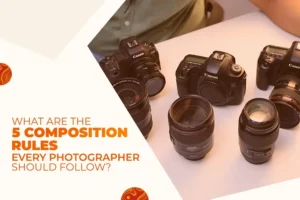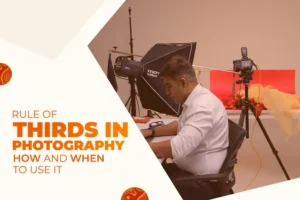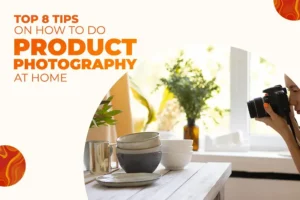What Do You Need For Product Photography?

Diving into product photography is exciting, and you don’t need fancy gear to get started. You can start with the very important ones and expand your arsenal as you grow as a photographer. Whether you’re a newbie photographer or a business owner trying your hand at it, let’s go through what you need to be a product photographer,
What Do You Need For Product Photography
1. Camera
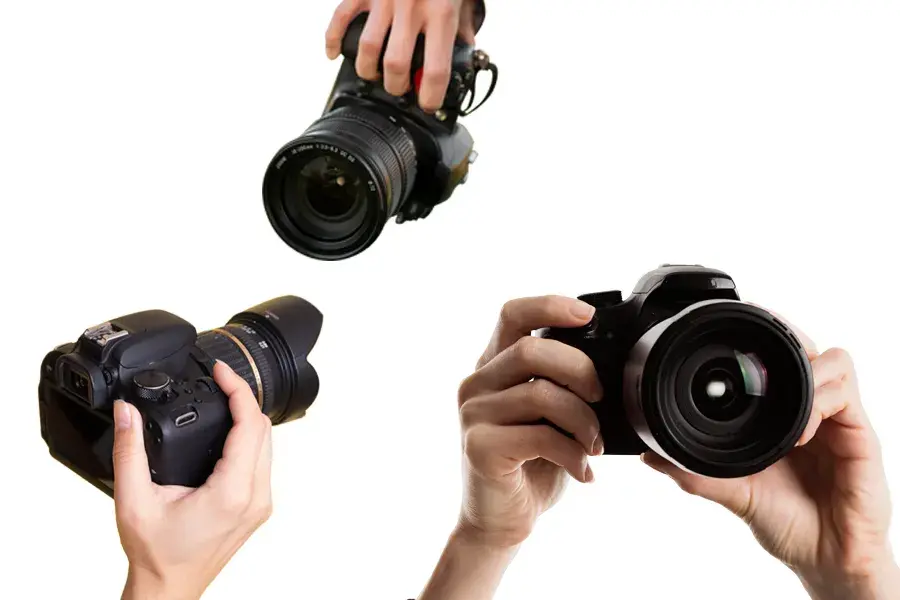
You might already have a good camera on your smartphone that takes nice photos. But if you want more control, consider a digital camera. There are some options in the market, which are not super expensive, and they let you play with settings to make your photos look better. Don’t fall for the myth that you need a pricey camera; it’s not just about the equipment. Your choices in lighting, style, and editing matter a lot.
In product photography, your aim is to capture the spirit of the product, not break the bank on a camera. Start with what you’ve got, try things out, and see how it goes. Remember, it’s not the camera doing all the work – it’s your decisions, from how you light the scene to what you do after you take the picture, that makes it great.
So, forget about needing the fanciest gadgets. Focus on being creative and making smart choices. Start small, learn, and soon your photos will be comparable to the images taken by expensive cameras.
Wanna learn in-depth how camera works, click here: How camera works
2. Tripod

Now, f-stop and shutter speed go hand in hand. A higher f-stop, like f/8, means less light is coming in, so you compensate by using a slower shutter speed to allow more light through. But here’s the thing: with a slow shutter, you can’t hold the camera by hand without getting blurry pictures. That’s where the tripod comes in handy, it stabilises the camera to get clear pictures.
3. Lighting
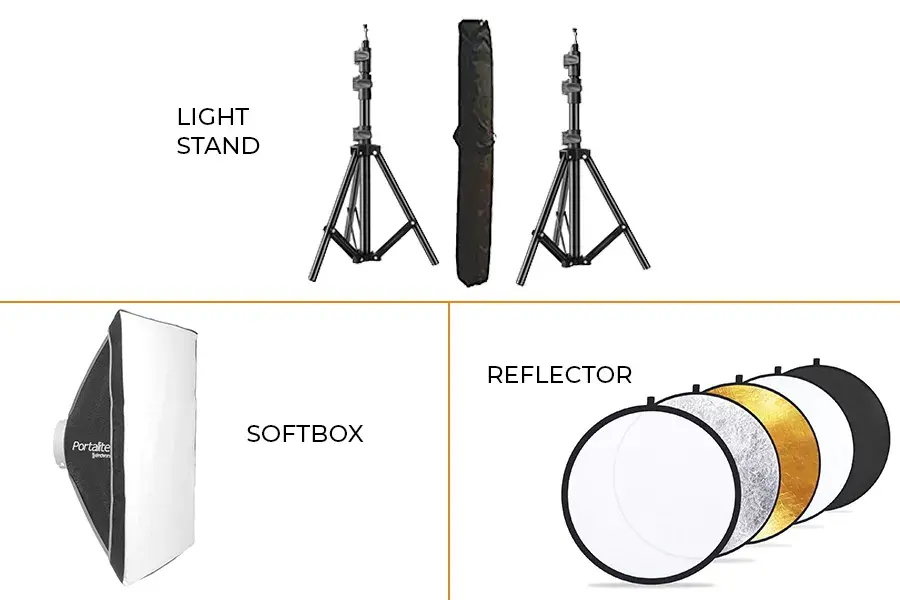
Lighting is the ultimate key to photography, and while natural light is fantastic, we can’t always rely on it. That’s where artificial light tools come into play.
A. Light Stands:
Think of light stands as reliable sidekicks for your camera. They play a crucial role in keeping your light sources steady, giving you full control over the lighting—whether you’re in a studio or outdoors.
Light stands come in various options, offering different heights, sizes, weights, durability, and mounting choices. Don’t forget about accessories! Consider extras like a carrying case, sandbags, weights, wheelsets, and mounting bases to improve your setup.
B. Softbox:
Meet the softbox, your lighting partner. It’s an alternative to light umbrellas but does the same job. With a softbox, you have complete control over your photo’s lighting. Position it above your product at a 45-degree angle for the best results. If you’re dealing with reflective objects, you might also want to explore a light tent to soften the light and eliminate pesky reflections.
C. Reflectors:
Enter reflectors—the budget-friendly heroes of our list. You don’t have to be a professional to appreciate what these can do for your photos. In just a few minutes, light reflectors can work wonders, transforming the quality of your product shots. They’re a fantastic investment for any photographer, professional or not.
4. White Background
Creating a clean, white background for your product photos doesn’t have to cost you a lot. A practical choice is a white sweep, especially if you’re into regular shooting. Choose a paper sweep; when it gets dirty, trim off the used part, and roll out a fresh piece. For a budget-friendly alternative, head to your local stationary or art store, where you can get poster board. Ensure it’s pure white, as editing off-white or cream backgrounds to pure white can be challenging.
If you want to learn in-depth how can you create white background for product photography, you can read it here: how to make white background for product photography
5. Table & Tape
For a solid base in product photography, a standard folding table is required, with an ideal width falling between 24 and 27 inches. Once you’ve got your table set up, depending on its design, you can use tape or clamps to secure your board in place, to get a perfect sweep background.
Tools For Editing Product Photos
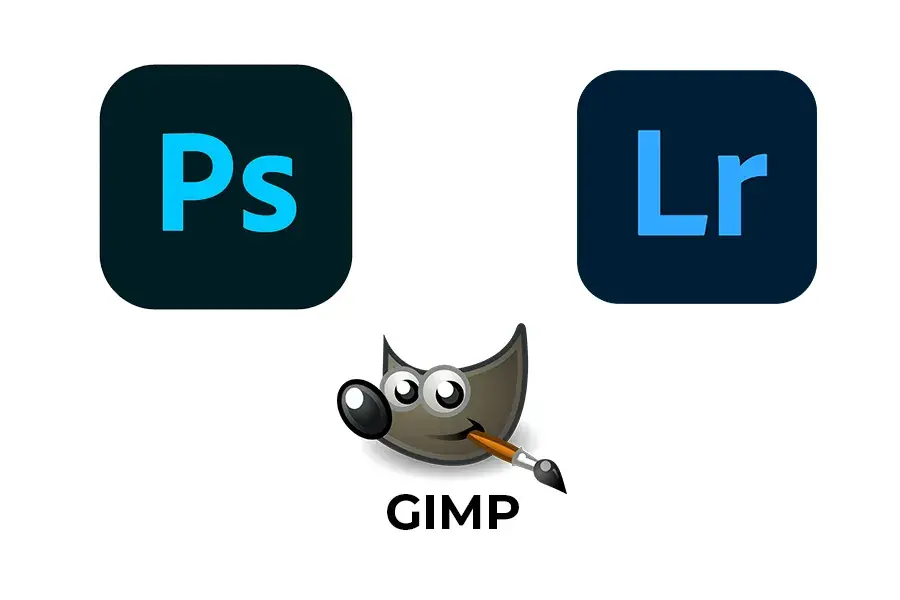
Clicking the perfect shot is just the beginning; the real magic happens during the editing process. Upgrade your product photography with these paid and free editing options:
1. Adobe Photoshop
Believed to be the powerhouse of photo editing, Adobe Photoshop can handle all your editing needs and more. While it comes with a price tag, there’s a budget-friendly alternative too that you can check. You can even test it with a free trial. If you’re into mobile editing, grab Photoshop Express for free on your phone.
2. Adobe Lightroom
Another gem from Adobe, Lightroom is a versatile tool for editing and organizing your photos. Perfect for managing large quantities, especially when used with Photoshop. It’s a fantastic help for colour correction, an important step in reducing product returns. Investing time in mastering these editing tools can turn a good photo into the amazing ones.
3. GIMP
Thinking about getting something free, well GIMP is here, a free alternative to Photoshop. While it might not match every Photoshop feature, GIMP offers a solid set of photo editing tools without costing a penny. Download GIMP to access most of the editing features you need, making it a budget-friendly choice for improving your product photos.
There are a lot of other tools that can help edit your pictures. Now, let’s have a look at what qualifications do you need for product photography,
What Qualifications Do You Need To Be A Product Photographer?

Download The Beginners Handbook For Product Photography
This handbook is your go-to guide for unleashing your creative potential. Don’t miss out – grab your FREE copy now!
1. Photography Skills
Forge a solid foundation in basic photography principles, mastering composition, framing, and exposure. Consider enrolling in photography courses or workshops to refine your skills and develop a keen eye.
2. Technical Knowledge
Become well-versed in camera settings, lighting techniques, and post-processing. Technical ability makes sure you can efficiently capture and improve images.
3. Creativity And Attention To Detail
Success in product photography depends on a keen eye for detail and a creative fire in you. Setting yourself apart means showcasing products in unique and appealing ways.
4. Communication Skills
Effective communication is crucial when working with clients or within a team. Understand client expectations, provide valuable suggestions, and ensure a seamless workflow.
Though you don’t need any formal education to be a product photographer but you do need strong skills to be a good product photographer.
In summary, the combination of equipment and qualifications in photography skills, technical knowledge and creativity are all you need for a successful career in product photography.
As you invest in the right tools and continue to refine your skills, you’ll find yourself ready to shine in the world of product photography.
If you want to speed up your learning speed and become a professional in product photography fast, join FDS Masterclass now! Learn from the industry expert, explore form basics to creative techniques and also how to pitch your dream clients and earn money through product photography. Join now here: Join FDS Masterclass
FAQs
1. What do I need for basic product photography?
For basic product photos, use a smartphone or digital camera. Get a white background (poster board works), a table, and tape. Consider a tripod for steady shots and simple lighting tools like a softbox or reflectors.
2. What equipment is used in product photography?
Start with a camera, smartphone, or digital. Add a tripod for stability. Use simple tools like a white background, softbox, reflectors, or a light tent for lighting effects. Explore free editing software like GIMP or Pixlr, or consider Adobe Photoshop and Lightroom.
3. What qualifications do you need to be a product photographer?
Develop basic photography skills—composition, framing, exposure. Understand your camera settings and lighting techniques. Be creative and detail-oriented. Communication skills help if working with clients or a team. While formal qualifications aren’t necessary, consider photography courses for improvement. Stay dedicated and adapt to industry trends for success.

